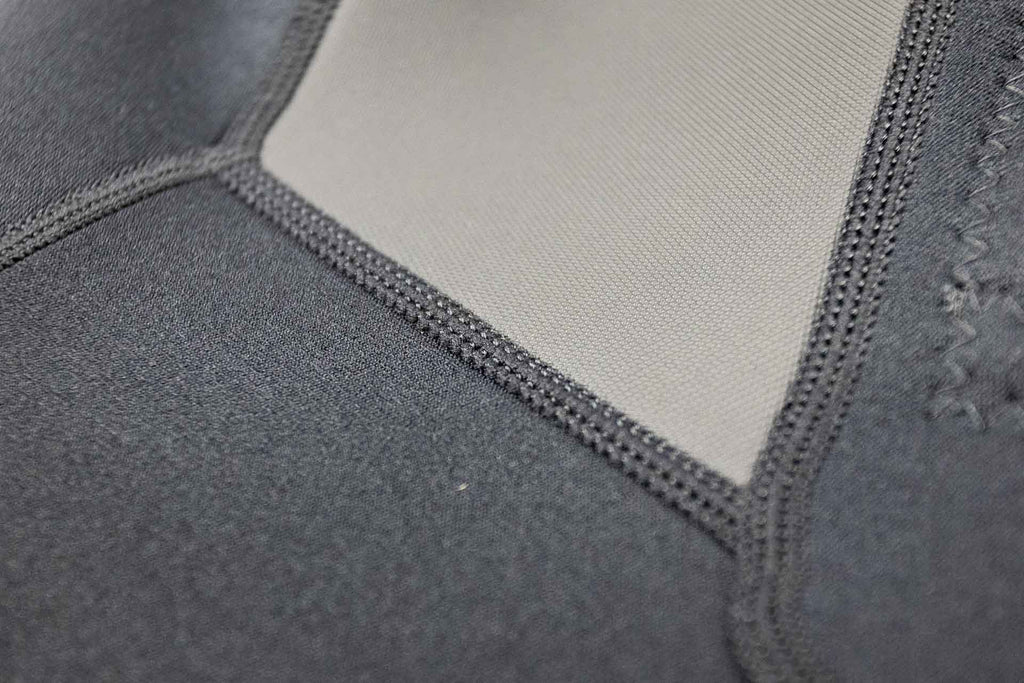Wetsuit seams can be sealed and reinforced using a wide variety of methods. In the hunt for the most watertight, flexible, and yet durable seam, manufacturers have applied the methods below to create a wide range of unique wetsuits.
Types of Seams
Flatlock

The Flatlock seam is the most basic and least expensive seam in the wetsuit world. Almost always found in wetsuits 3mm and under as well as springsuits 2mm and under. All flatlock suits are also glued to make the seam as watertight as possible, but due to the nature of the stitch, this seam is the least watertight and durable.
GBS (Glued and Blind Stitched) Seam

The Glued and Blindstitched seam is typically found in entry-level to mid-range wetsuits. The blind stitch technique does not completely penetrate through both sides of the neoprene, which creates a completely watertight, durable seam.
Fluid Sealed

Fluid Sealed seams have many names among wetsuit manufacturers and are all a little bit different. In most cases, you will see a seam that is sealed on the outside. Sometimes, sealed seams are stitched on the inside.
Taped Seams

Taping comes in many different forms and is generally only in select parts of a suit on the interior. You can find wetsuits where the interior is fully taped, partially taped, or critically taped. Each has its own benefits and drawbacks.
Stitch Free Seams

Found on premium high-end wetsuits; this new breakthrough seam technology creates a more durable and warmer wetsuit. Over time, seams are typically the first area to fail. Sometimes referred to as Dry Seam Technology, stitch-free seams hold up better over time compared to traditional seam construction.
Choosing the Right Seams
Besides the different types of seams, there can be combinations of these seam types in different parts of a wetsuit. You typically see this happening in Fullsuits. For instance, you might find a suit that is GBS in the arms but fluid sealed in the legs and body. This makes a durable suit with flexibility where it is most needed, in the arms. Some suits have a fluid seal on the outside and an internal tape on the inside. This makes a very durable seam but adds weight to the suit and detracts from flexibility. The best suit has the right seams in the right places, giving you the perfect balance of flexibility, weight, and warmth.
A Few Notes on Paneling and How it Affects the Wetsuit
A panel is basically one piece of neoprene, and the seams are where the neoprene pieces are attached. Paneling can affect the fit as well as the flexibility of a wetsuit. We won’t go into too much detail, but a rule of thumb is this: fewer panels equals fewer seams, and fewer seams equals fewer “moving parts” or areas where the suit can break down or restrict your movement. More panels equate to a better fit, and as with all things, the trick is finding the sweet spot. Newer, stretchier neoprene has allowed wetsuit manufacturers to create wetsuits with fewer seams while retaining a good fit. This is why quality wetsuit manufacturers spend a lot of time developing the proper seams to maximize flexibility while keeping the fit of the suit accurate.
Another nice trick manufacturers use panels for is putting different types of neoprene in different areas. This allows for a more technical suit. For instance, a high-end suit for cold water might feature a smooth skin chest panel, which is made of a special type of neoprene that blocks wind and absorbs heat from the sun better.
How Wetsuit Seams & Paneling Affect Flexibility
The flexibility of a wetsuit is greatly influenced by the seams used on it. There aren’t really hard and fast rules, but generally, the more material used to reinforce the seam, the less flexible it will be. Sometimes, you’ll see wetsuits that are sealed on the outside and taped on the inside, and this can hinder flexibility in those areas. In higher-end suits, manufacturers will use stretchier material to compensate for this.
How Wetsuit Seams & Paneling Affect Warmth
The key here is to have a watertight wetsuit. That’s what seams need to do well, but some seams do a better job than others. Flatlock seams are the most basic and simple seam type. After that, you have a pretty good watertight seal with all other seams right off the bat, but GBS seams will break down and start leaking a bit sooner than taped seams or fluid seams. After the seam begins breaking down and letting in water, it’s going to start getting cold, so the key is to look for durable seams if you want to stay warm a year after you purchase the suit.
How Wetsuit Seams & Paneling Affect Durability
There are a lot of seam options out there, and most wetsuits use multiple types of seams throughout. The rule of thumb is the more material they are using, the stronger the seam is going to be. However, some exceptions to this rule exist in the higher-end suits that use fluid seam welds without any stitching.
How Wetsuit Seams & Paneling Affect Fit
Wetsuit seams do play a small role in the fit of a wetsuit. When you add more seams, there is the potential to be more specific with the shape of the wetsuit, which can lead to a better fit, but more seams also can mean less flexibility, which can lead to a worse fit. It’s the balance that is important.
